World nuclear power in 2018
Overview of major changes in nuclear power over the past year.
In 2018, the nuclear power industry played out for the failures of commissioning in 2017 - 10,400 megawatts of new capacity was connected to the network (against 3,305 megawatts in 2017), while 2,827 megawatts of old were closed, thus the total capacity of nuclear power plants increased by 7.57 GW from 392.6 GW up to 400.2 (400 gigawatts of nuclear power rated for the first time, 400 get so to speak). Over the last 4 years, as a result, changes in capacity look like this: 2015 + 7.9 GW, 2016 +9.2 GW, 2017 +1.075, 2018 + 6.6 - an average of ~ 6.4 GW of growth per year . The nuclear renaissance of the second half of the 2000s has already ended, and we are reaping its benefits today.
Unlike me, base PRISconsiders the moment of birth of new units slightly unintelligible - somewhere this is the first connection to the network, and somewhere the “beginning of commercial exploitation”, i.e. the end of all sorts of tests on power, which on average take about six months after the first criticism of the reactor (according to which I usually count new units). From here there will be a certain discrepancy with the previous annual statistics , and there may be conflicts with other statistics on connection dates.
In total, 9 new power units were put into operation, 3 old ones were finally shut down, construction of 5 new ones started (and 3 of them with Rosatom). All commissioned units belonged to the PWR / VVER technology, i.e. two-circuit pressure water reactors. Let's look at them closer.
1. So, the first in 2018, the 4th unit of the Rostov NPP, the classic VVER-1000, entered the new commercial operation.
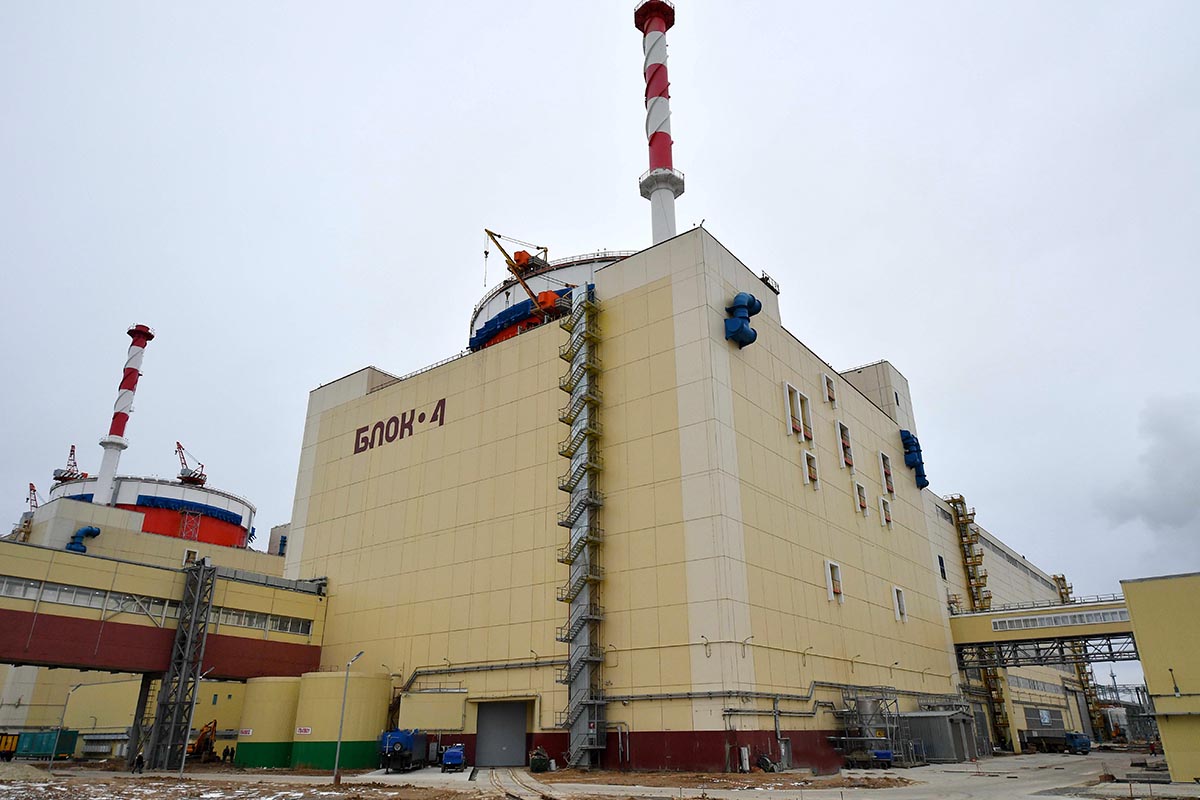
The net power of the unit, which is counted by PRIS is 1011 megawatts, the total (from which the expenses for the own needs of the unit are subtracted) is 1070 megawatts. The construction of the block began in 2010, physical start was made on December 29, 2018.
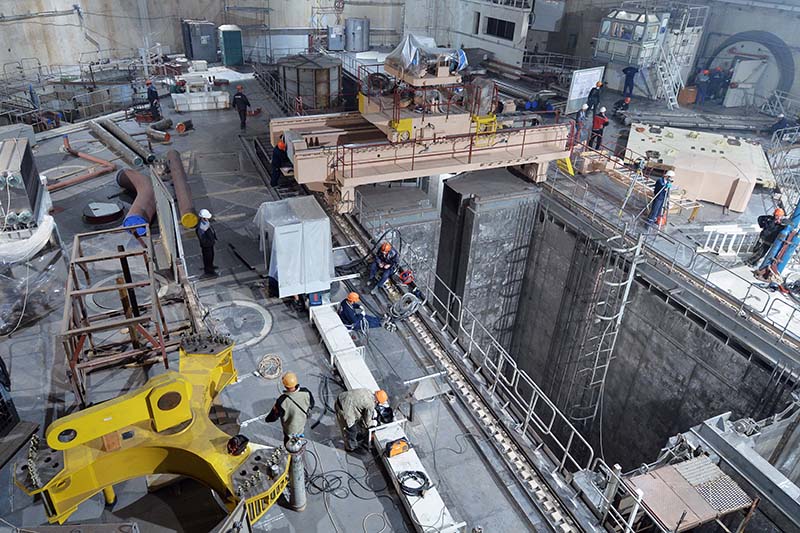
View of the hermetic separation of the reactor 4 of the Rostov NPP unit during installation - the spent fuel storage pool, the transshipment machine and after it - the reactor shaft.
2. The second network connection in 2018 was also made in Russia at block 1 of the Leningrad NPP-2. The power unit with the VVER-1200 “Leningrad version” (as usual with us, one type of new gigawatt unit for the country is not enough - for the VVER-1200 there is a “Moscow” version, which are being built at NVAES and now “Leningrad”) to replace the outgoing LNPP-1 (as is known, block 1 of this LNPP was stopped forever on December 22, 2018, so the replacement arrived just in time). The construction of the unit took about 10 years and cost 160 billion rubles.

The first block of LNPP during construction.
3. All the remaining launches of 2018 occurred in China, and the first Chinese was the 5th Yangjiang NPP unit with an ACPR-1000 reactor, which was connected to the network on May 23, 2018. Interestingly, this is another Chinese block that has gone from the first concrete to the connection to the network in less than 5 years (09/18/2013–23/05/2018). Well, as you can understand, this 6th unit in a 6-block NPP with CPR-1000, CPR-1000 + and ACPR-1000 reactors is all an evolutionary development of the French CP0 type reactor.
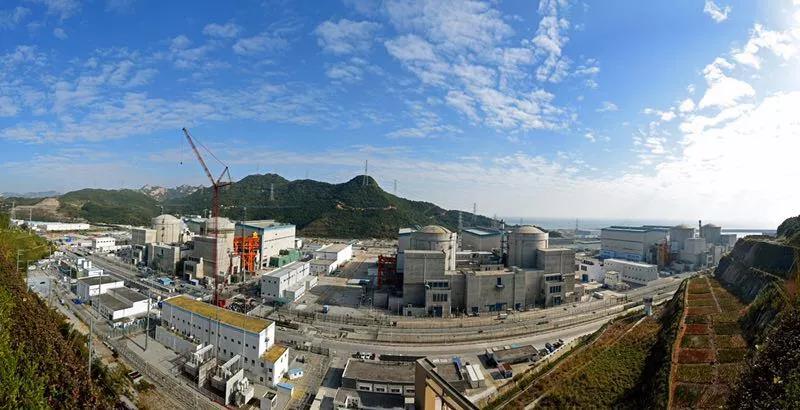
Panorama NPP Yangjiang. The fifth block is the second on the left.
4. The next Chinese unit connected to the grid on June 30 was 1 unit Taishan NPP (Taishan) with the most powerful reactor in the world EPR-1700 (1660 megawatts of usable power) of French design. I wrote in detailand about the reactor and its adventures (almost 13 years passed from the start of the first construction with this type to the first start) and about a specific Taishan project. It only remains to add that after connecting to the network, the developers had problems with the process control system that did not allow the unit to be brought to full capacity, however, before the end of 2018, these problems were resolved, and in December the unit went into commercial operation. Well, congratulations to the French developers of the Republic of Uzbekistan and the Chinese builders.
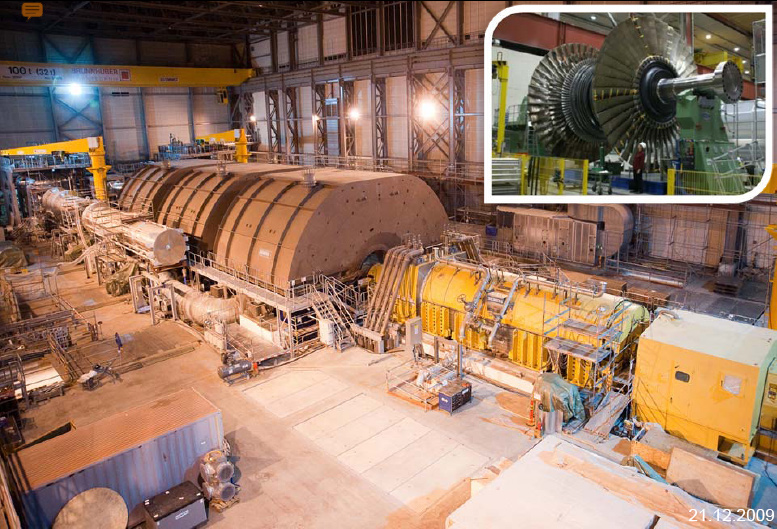
Turbine generator Taishan-1 - the largest steam turbine in the world.
5. Immediately after the long-awaited launch of the first generation III + western project (after the VVER-1200, APR-1400 and ABWR, which also claimed the “III +” in a certain sense), Sanmenmen (SANMEN) was launched with an AP-1000 reactor (again a candidate for III + In fact, the criteria for this classification are so blurred that you can write a lot of things there). This project was delayed compared to the initial plans for almost five years and eventually became very loud and scandalous. In more detail about this event in a separate post and in one more - the description of technological features of AP-1000. Here I will only add that the real total power of the AP-1000 is about 1250 megawatts, i.e. it is even more powerful than the VVER-1200 and is comparable to the VVER-1300. And PRIS recorded for the Sanmen-1 1157 MW of net electrical power.
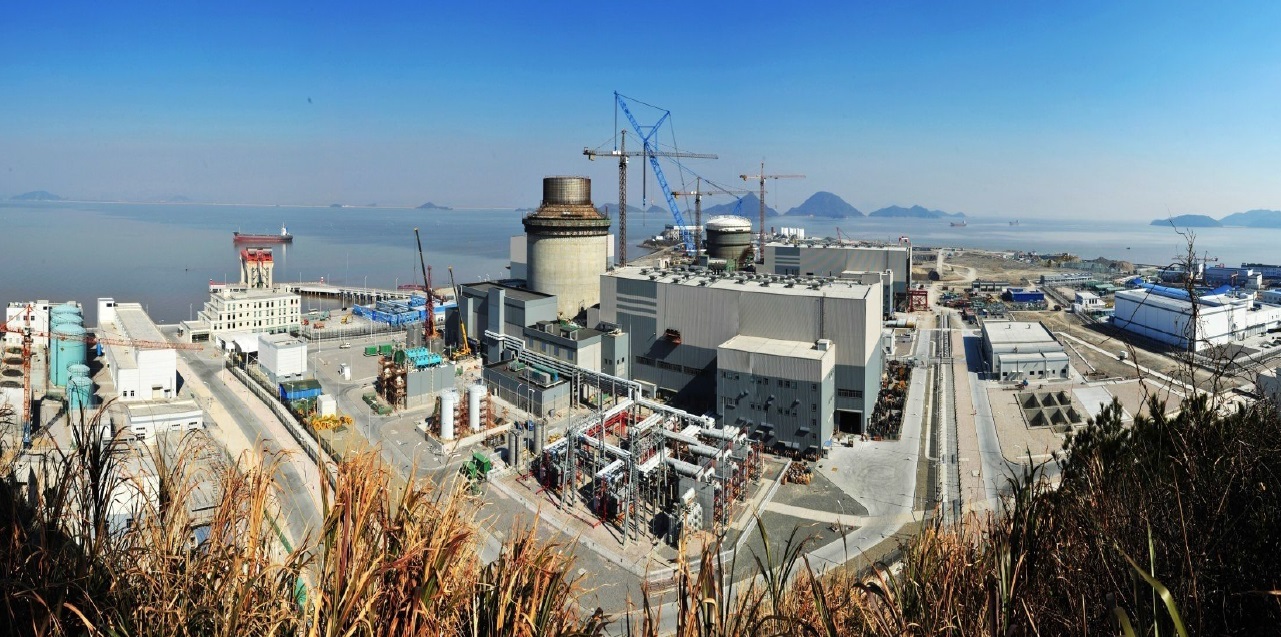
The first two units of the Sanmen NPP are under construction. In general, another 4 blocks with the AP-1000 / CAP-1000 are planned, but for the time being this continuation has been suspended for political reasons.
6,7,8. Here, the Chinese decided to surprise the whole world, after the first AP-1000 three more blocks of this type were immediately launched (for the first time in history, 4 newer blocks are introduced at once in one quarter) - Sanmen-2 August 24, Hyang-1 (HAIYANG) on August 17 and Hayang 2 October 13.
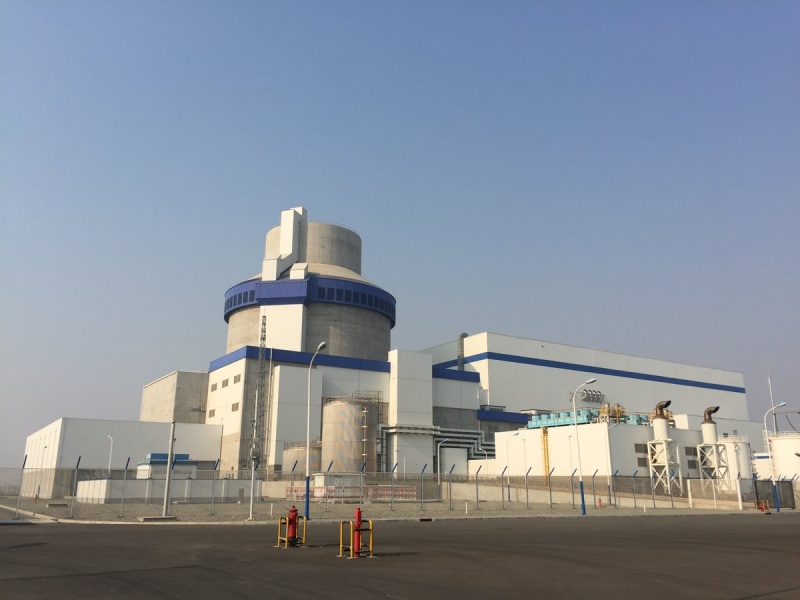
The first block of Haiyang NPP with AP-1000 reactor. It looks, in my opinion, quite interesting, despite the traditional dull concrete.
9. Finally, the last connection of 2018 was the 5th unit of the Tavan NPP with the VVER-1000 reactor, thus all three major foreign competitors in the Chinese market showed their capabilities in 2018. Another 990 megawatts in the Chinese piggy bank.

Four blocks of Tianwan NPP built by the Chinese according to the domestic VVER-1000 project.
The final shutdowns in 2018, as usual, were more diverse in the appearance of the closed NPPs. The first in 2018 was retired single-block NPP Oyster Creek, located in New Jersey, USA. The boiling reactor nuclear power plants of the General Electric BWR-2 type in the Mark-1 containment (exactly the same configuration as unit 1 of the Fukushima nuclear power plant) were connected to the network on December 1, 1969 and had a license to work until December 1, 2029.

The main reason for the closure was the unprofitability of nuclear power plants in terms of cheap gas and the need to perform work on the modernization of nuclear power plants in the face of problems with NPP equipment found by the controller. For 49 years of work in the NPP Disposal Fund, she managed to accumulate $ 982 million, which, apparently, will be enough to completely eliminate the plant according to the “green site + dry SNF container storage” scheme. At present, Holtec bought the nuclear power plant, which, with the money of the fund, undertakes to carry out decommissioning and liquidation of the station for 8 years.
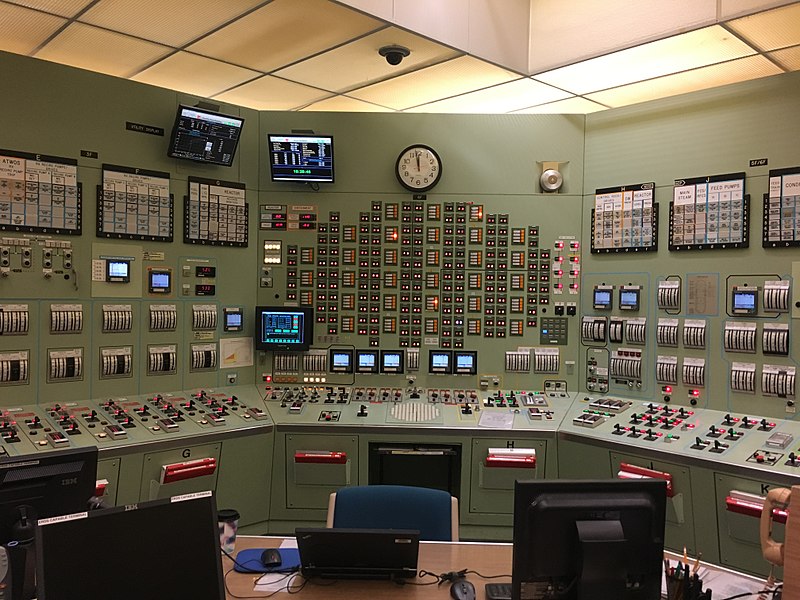
Training simulator of the control panel of the power unit NPP Oyster Creek
On October 3, the two-unit Taiwan NPP Jinshan (or Chinshan - there are different transcriptions) went to rest, with both blocks at once. This is also the 2 General Electric BWR-4 in Mark-2 enclosures, with a capacity of 604 megawatts of electrical, launched on December 10, 1978 and July 15, 1979.

The nuclear power plant is closed as part of a “planned” non-renewal of the license for a 40-year milestone in the face of the collapse of nuclear power by Taiwan. However, after the closure, a referendum was held, where the people of Taiwan called for the presence of atomic facilities on the island, which was unpleasant news for the anti-nuclear government. However, the fate of Jinshan is not affected in any way. The owner of the nuclear power plant has deposited ~ $ 600 million for the future dismantling of nuclear power plants, which, however, will be stretched for at least 25 years, so the amount is still likely to grow.
Finally, on December 22, 1 unit of the Leningrad NPP, the firstborn of the Soviet series of RBMK type reactors and gigawatt power units, was shut down. Connected to the network on December 22, 1973, it worked for exactly 45 years and was stopped for a planned non-renewal of the license in the context of the growing cost of maintaining the power unit and the availability of replacement capacity.
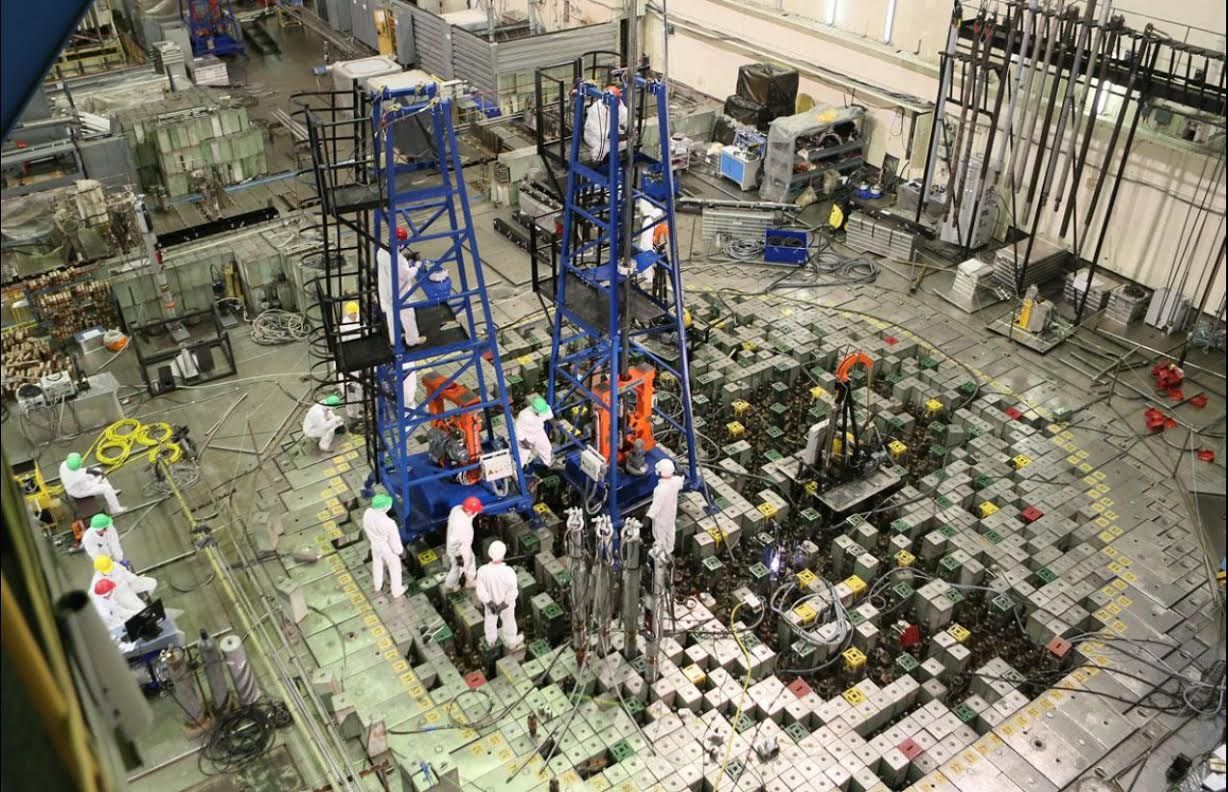
Five years before stopping, a large " surgery " on a curved graphite stack was performed at block 1 of the LNPP .
Like the rest of RBMK, there are problems with decommissioning - a complex and extensive construction, the presence of 2000+ tons of irradiated graphite means that bringing the Leningrad NPP to the “green site” will be a very long and expensive procedure. An example of how this is done can be found in this article .
In 2018, construction began on just 5 blocks, with 3 of them being Rosatom's projects. Formally, the first “first concrete” in 2018 was the beginning of the construction of Akkuyu NPP Unit 1 in Turkey with VVER-1300 / TOI reactors. However, in reality, the first concrete was poured somewhere in October 2018.
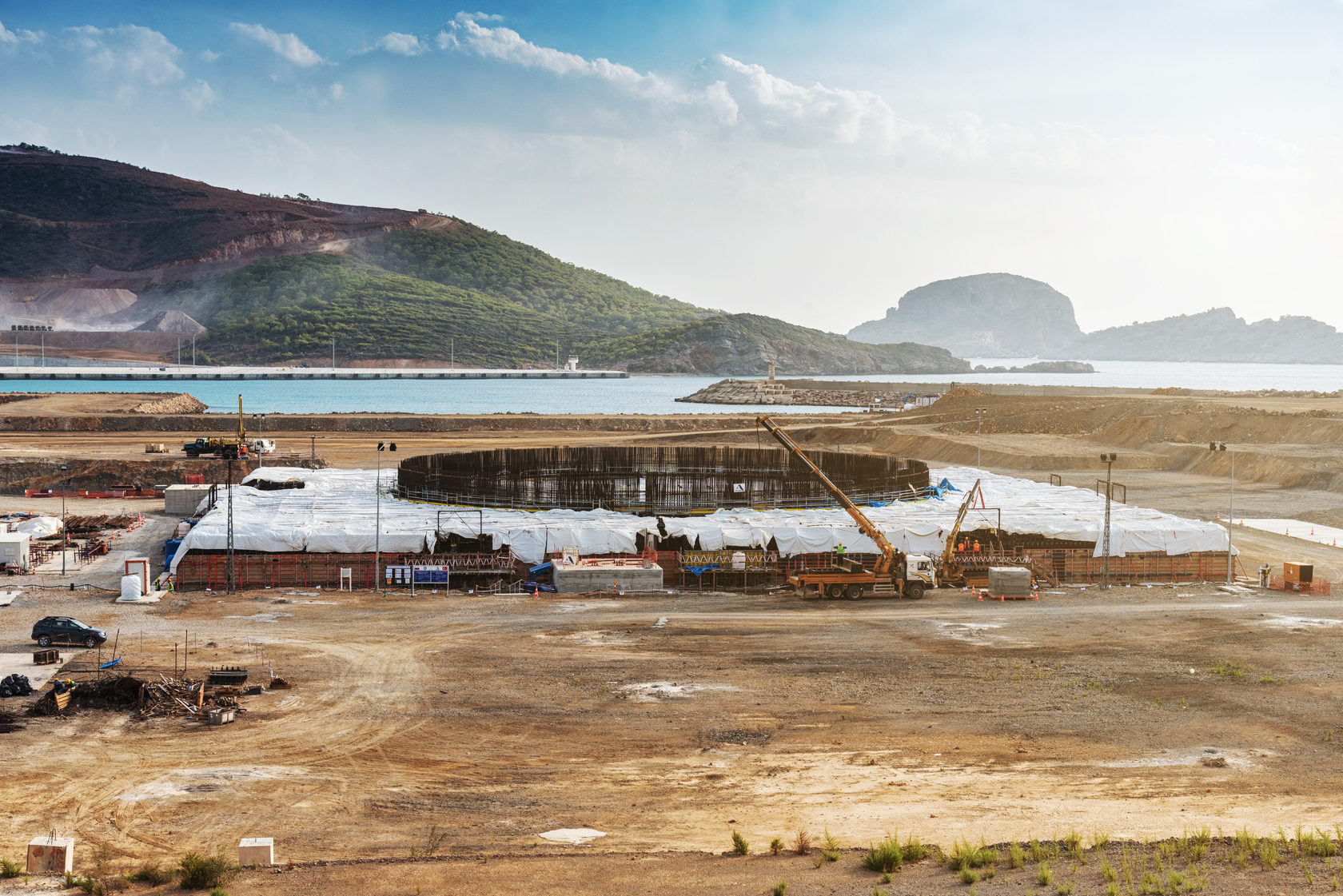
This NPP should be the first in Turkey, which has a large power shortage, but due to the difficult relations between Turkey and Russia, the project has certain chances to never reach the start-up of the reactor.
On April 29, the first concrete was poured into the foundation slab of unit 1 of Kursk NPP-2 with a VVER-1300 / TOI reactor; there was no real and formal date here.
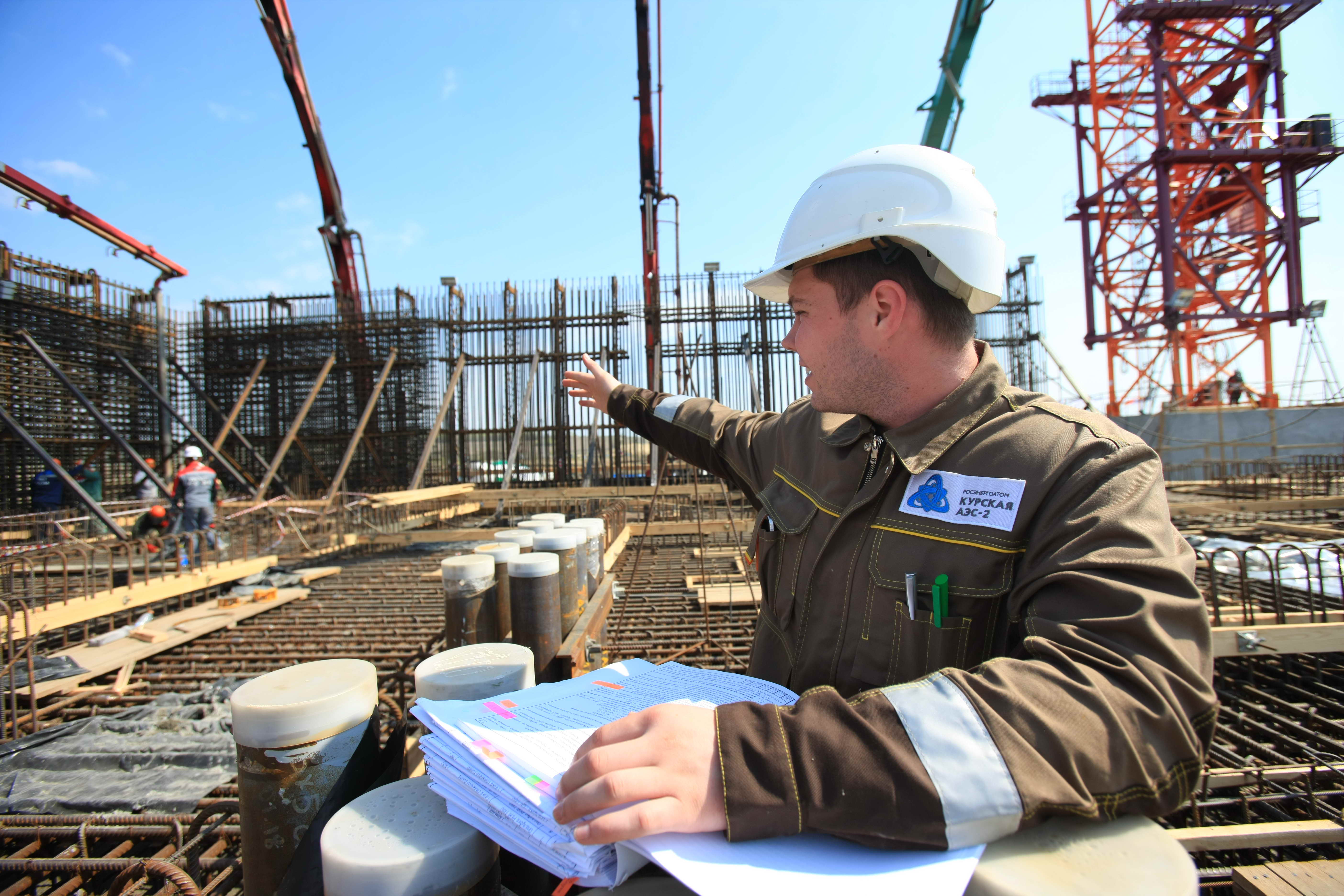
This is the second project of replacing nuclear power plants with RBMK (now, as we know, Kursk) and at the same time the first nuclear power plant with a VVER-TOI reactor, which, according to the designers, should be cheaper, easier and faster to build. Evaluate the simplicity, speed and cheapness can be in 5-8 years.
Finally, on July 14, 2018 in the presence of the Prime Minister of Bangladesh, the first concrete was poured into the foundation of Unit 1 of Ruppur.
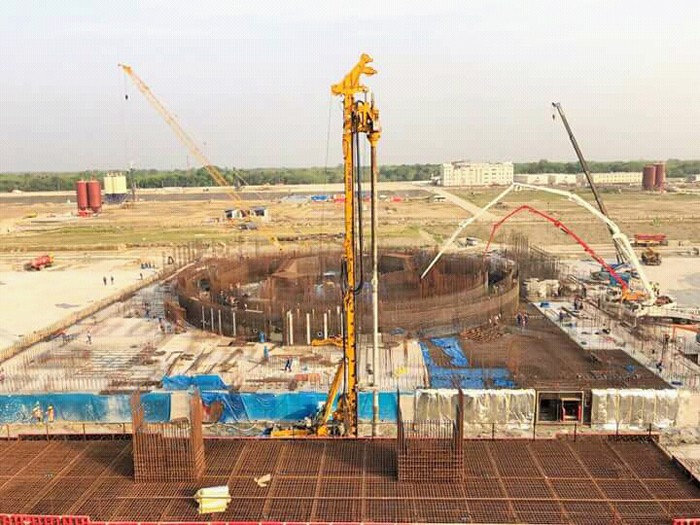
A two-unit Ruppur NPP with a VVER-1000 is being built in a country where the average power generation capacity does not exceed 6 GW in the area of the Bhemara energy center on the banks of the Padma River (lower part of the Ganges). Given the hard energy deficit in the 160 million country, the project has all chances to be realized.

Installing the embedded part of the Melt Localization Device (HRM, also known as the "melt trap") on the foundation of the "nuclear island", Ruppur NPP.
In September, the Korean KHNP took over the baton from Rosatom, resuming the construction of Unit 6 of the Shin Kori NPP with the APR-1400 reactor . This unit started back in 2016, but after the election of the new “green” president of South Korea, Moon Jae-in, this construction was suspended.

Construction Shin Kori 6.
The final "newcomer" of 2018 is the first Hinkley Point C NPP unit with an EPR-1700 reactor. The new English NPP, known for its incredibly high cost, is being built quite dynamically, but at the same time some kind of “first atomic concrete” was announced only in December 2018, although in the summer of 2018 the situation looked like this
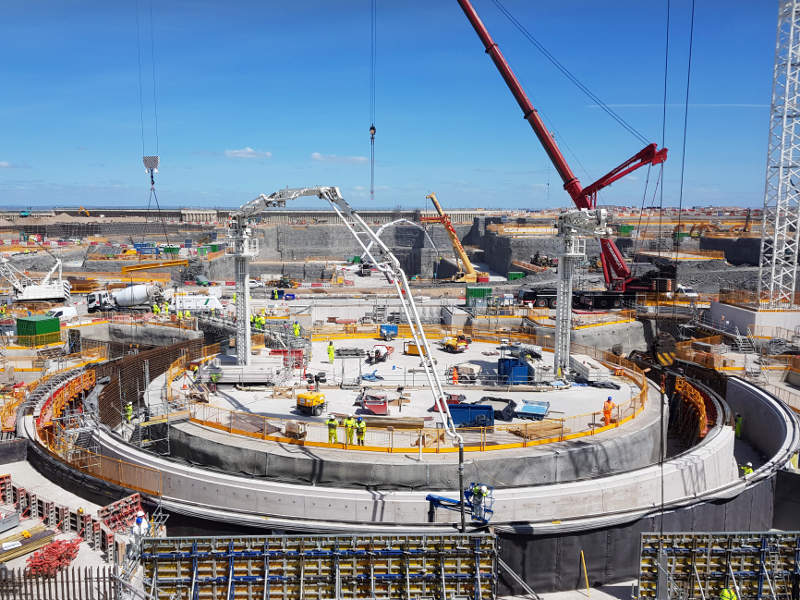
I don’t understand how this round thing can not to be the base of the nuclear island of the block, and the concrete in it to be non-nuclear, but oh well. Anyway, EDF announced the first nuclear concrete, marking the beginning of the official construction of the fifth EPR-1700 reactor in the world.

This was the year 2018 in terms of the main events of nuclear power. I hope in the near future to also write about the plans for start-up for 2019, as I did this last year.so you can then evaluate the "marketability".
In 2018, the nuclear power industry played out for the failures of commissioning in 2017 - 10,400 megawatts of new capacity was connected to the network (against 3,305 megawatts in 2017), while 2,827 megawatts of old were closed, thus the total capacity of nuclear power plants increased by 7.57 GW from 392.6 GW up to 400.2 (400 gigawatts of nuclear power rated for the first time, 400 get so to speak). Over the last 4 years, as a result, changes in capacity look like this: 2015 + 7.9 GW, 2016 +9.2 GW, 2017 +1.075, 2018 + 6.6 - an average of ~ 6.4 GW of growth per year . The nuclear renaissance of the second half of the 2000s has already ended, and we are reaping its benefits today.
Unlike me, base PRISconsiders the moment of birth of new units slightly unintelligible - somewhere this is the first connection to the network, and somewhere the “beginning of commercial exploitation”, i.e. the end of all sorts of tests on power, which on average take about six months after the first criticism of the reactor (according to which I usually count new units). From here there will be a certain discrepancy with the previous annual statistics , and there may be conflicts with other statistics on connection dates.
In total, 9 new power units were put into operation, 3 old ones were finally shut down, construction of 5 new ones started (and 3 of them with Rosatom). All commissioned units belonged to the PWR / VVER technology, i.e. two-circuit pressure water reactors. Let's look at them closer.
New blocks
1. So, the first in 2018, the 4th unit of the Rostov NPP, the classic VVER-1000, entered the new commercial operation.

The net power of the unit, which is counted by PRIS is 1011 megawatts, the total (from which the expenses for the own needs of the unit are subtracted) is 1070 megawatts. The construction of the block began in 2010, physical start was made on December 29, 2018.

View of the hermetic separation of the reactor 4 of the Rostov NPP unit during installation - the spent fuel storage pool, the transshipment machine and after it - the reactor shaft.
2. The second network connection in 2018 was also made in Russia at block 1 of the Leningrad NPP-2. The power unit with the VVER-1200 “Leningrad version” (as usual with us, one type of new gigawatt unit for the country is not enough - for the VVER-1200 there is a “Moscow” version, which are being built at NVAES and now “Leningrad”) to replace the outgoing LNPP-1 (as is known, block 1 of this LNPP was stopped forever on December 22, 2018, so the replacement arrived just in time). The construction of the unit took about 10 years and cost 160 billion rubles.

The first block of LNPP during construction.
3. All the remaining launches of 2018 occurred in China, and the first Chinese was the 5th Yangjiang NPP unit with an ACPR-1000 reactor, which was connected to the network on May 23, 2018. Interestingly, this is another Chinese block that has gone from the first concrete to the connection to the network in less than 5 years (09/18/2013–23/05/2018). Well, as you can understand, this 6th unit in a 6-block NPP with CPR-1000, CPR-1000 + and ACPR-1000 reactors is all an evolutionary development of the French CP0 type reactor.

Panorama NPP Yangjiang. The fifth block is the second on the left.
4. The next Chinese unit connected to the grid on June 30 was 1 unit Taishan NPP (Taishan) with the most powerful reactor in the world EPR-1700 (1660 megawatts of usable power) of French design. I wrote in detailand about the reactor and its adventures (almost 13 years passed from the start of the first construction with this type to the first start) and about a specific Taishan project. It only remains to add that after connecting to the network, the developers had problems with the process control system that did not allow the unit to be brought to full capacity, however, before the end of 2018, these problems were resolved, and in December the unit went into commercial operation. Well, congratulations to the French developers of the Republic of Uzbekistan and the Chinese builders.

Turbine generator Taishan-1 - the largest steam turbine in the world.
5. Immediately after the long-awaited launch of the first generation III + western project (after the VVER-1200, APR-1400 and ABWR, which also claimed the “III +” in a certain sense), Sanmenmen (SANMEN) was launched with an AP-1000 reactor (again a candidate for III + In fact, the criteria for this classification are so blurred that you can write a lot of things there). This project was delayed compared to the initial plans for almost five years and eventually became very loud and scandalous. In more detail about this event in a separate post and in one more - the description of technological features of AP-1000. Here I will only add that the real total power of the AP-1000 is about 1250 megawatts, i.e. it is even more powerful than the VVER-1200 and is comparable to the VVER-1300. And PRIS recorded for the Sanmen-1 1157 MW of net electrical power.

The first two units of the Sanmen NPP are under construction. In general, another 4 blocks with the AP-1000 / CAP-1000 are planned, but for the time being this continuation has been suspended for political reasons.
6,7,8. Here, the Chinese decided to surprise the whole world, after the first AP-1000 three more blocks of this type were immediately launched (for the first time in history, 4 newer blocks are introduced at once in one quarter) - Sanmen-2 August 24, Hyang-1 (HAIYANG) on August 17 and Hayang 2 October 13.

The first block of Haiyang NPP with AP-1000 reactor. It looks, in my opinion, quite interesting, despite the traditional dull concrete.
9. Finally, the last connection of 2018 was the 5th unit of the Tavan NPP with the VVER-1000 reactor, thus all three major foreign competitors in the Chinese market showed their capabilities in 2018. Another 990 megawatts in the Chinese piggy bank.

Four blocks of Tianwan NPP built by the Chinese according to the domestic VVER-1000 project.
Closures
The final shutdowns in 2018, as usual, were more diverse in the appearance of the closed NPPs. The first in 2018 was retired single-block NPP Oyster Creek, located in New Jersey, USA. The boiling reactor nuclear power plants of the General Electric BWR-2 type in the Mark-1 containment (exactly the same configuration as unit 1 of the Fukushima nuclear power plant) were connected to the network on December 1, 1969 and had a license to work until December 1, 2029.

The main reason for the closure was the unprofitability of nuclear power plants in terms of cheap gas and the need to perform work on the modernization of nuclear power plants in the face of problems with NPP equipment found by the controller. For 49 years of work in the NPP Disposal Fund, she managed to accumulate $ 982 million, which, apparently, will be enough to completely eliminate the plant according to the “green site + dry SNF container storage” scheme. At present, Holtec bought the nuclear power plant, which, with the money of the fund, undertakes to carry out decommissioning and liquidation of the station for 8 years.

Training simulator of the control panel of the power unit NPP Oyster Creek
On October 3, the two-unit Taiwan NPP Jinshan (or Chinshan - there are different transcriptions) went to rest, with both blocks at once. This is also the 2 General Electric BWR-4 in Mark-2 enclosures, with a capacity of 604 megawatts of electrical, launched on December 10, 1978 and July 15, 1979.

The nuclear power plant is closed as part of a “planned” non-renewal of the license for a 40-year milestone in the face of the collapse of nuclear power by Taiwan. However, after the closure, a referendum was held, where the people of Taiwan called for the presence of atomic facilities on the island, which was unpleasant news for the anti-nuclear government. However, the fate of Jinshan is not affected in any way. The owner of the nuclear power plant has deposited ~ $ 600 million for the future dismantling of nuclear power plants, which, however, will be stretched for at least 25 years, so the amount is still likely to grow.
Finally, on December 22, 1 unit of the Leningrad NPP, the firstborn of the Soviet series of RBMK type reactors and gigawatt power units, was shut down. Connected to the network on December 22, 1973, it worked for exactly 45 years and was stopped for a planned non-renewal of the license in the context of the growing cost of maintaining the power unit and the availability of replacement capacity.

Five years before stopping, a large " surgery " on a curved graphite stack was performed at block 1 of the LNPP .
Like the rest of RBMK, there are problems with decommissioning - a complex and extensive construction, the presence of 2000+ tons of irradiated graphite means that bringing the Leningrad NPP to the “green site” will be a very long and expensive procedure. An example of how this is done can be found in this article .
New construction started
In 2018, construction began on just 5 blocks, with 3 of them being Rosatom's projects. Formally, the first “first concrete” in 2018 was the beginning of the construction of Akkuyu NPP Unit 1 in Turkey with VVER-1300 / TOI reactors. However, in reality, the first concrete was poured somewhere in October 2018.

This NPP should be the first in Turkey, which has a large power shortage, but due to the difficult relations between Turkey and Russia, the project has certain chances to never reach the start-up of the reactor.
On April 29, the first concrete was poured into the foundation slab of unit 1 of Kursk NPP-2 with a VVER-1300 / TOI reactor; there was no real and formal date here.

This is the second project of replacing nuclear power plants with RBMK (now, as we know, Kursk) and at the same time the first nuclear power plant with a VVER-TOI reactor, which, according to the designers, should be cheaper, easier and faster to build. Evaluate the simplicity, speed and cheapness can be in 5-8 years.
Finally, on July 14, 2018 in the presence of the Prime Minister of Bangladesh, the first concrete was poured into the foundation of Unit 1 of Ruppur.

A two-unit Ruppur NPP with a VVER-1000 is being built in a country where the average power generation capacity does not exceed 6 GW in the area of the Bhemara energy center on the banks of the Padma River (lower part of the Ganges). Given the hard energy deficit in the 160 million country, the project has all chances to be realized.

Installing the embedded part of the Melt Localization Device (HRM, also known as the "melt trap") on the foundation of the "nuclear island", Ruppur NPP.
In September, the Korean KHNP took over the baton from Rosatom, resuming the construction of Unit 6 of the Shin Kori NPP with the APR-1400 reactor . This unit started back in 2016, but after the election of the new “green” president of South Korea, Moon Jae-in, this construction was suspended.

Construction Shin Kori 6.
The final "newcomer" of 2018 is the first Hinkley Point C NPP unit with an EPR-1700 reactor. The new English NPP, known for its incredibly high cost, is being built quite dynamically, but at the same time some kind of “first atomic concrete” was announced only in December 2018, although in the summer of 2018 the situation looked like this

I don’t understand how this round thing can not to be the base of the nuclear island of the block, and the concrete in it to be non-nuclear, but oh well. Anyway, EDF announced the first nuclear concrete, marking the beginning of the official construction of the fifth EPR-1700 reactor in the world.

This was the year 2018 in terms of the main events of nuclear power. I hope in the near future to also write about the plans for start-up for 2019, as I did this last year.so you can then evaluate the "marketability".
